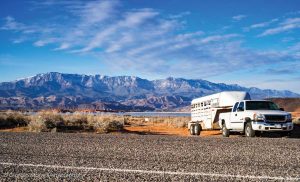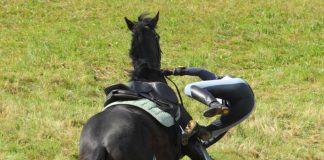 With the change of seasons, USRider, the national provider of roadside emergency assistance for equestrians, reminds those who travel with horses to be careful when traveling and to invest time doing routine preventive trailer maintenance to enhance travel safety.
With the change of seasons, USRider, the national provider of roadside emergency assistance for equestrians, reminds those who travel with horses to be careful when traveling and to invest time doing routine preventive trailer maintenance to enhance travel safety.
Kittrel Scheve says that during anytime of the year—regardless of temperatures—the basic rules apply:
- Make sure your trailer is safe.
- Drive carefully.
- Make sure the horse’s inoculations are up-to-date.
- Carry a current health certificate and certificate of negative EIA if crossing state lines.
- Wrap all four legs with shipping wraps or boots.
- Carry an emergency first aid kit and know how to use it.
- Learn to monitor vital signs of the horse.
- Carry backup supplies appropriate to the length of the trip.
- Carry emergency contact numbers for yourself and your horses and keep in a visible place.
- Carry a truck/car emergency kit. During the winter months, be sure the kit includes a shovel, sand, red flag, horse blankets, human blankets, candle, matches or lighter, and tire chains.
It’s also prudent to have a first-rate roadside assistance program to help in the event of an emergency.
“A good roadside assistance program is something all horse owners should have but hope they will never have to use,” says Mark Cole, managing member for USRider. “To that end, our mission is to continually educate horse owners about trailering safety.”
It is very important to make sure your vehicle is ready for winter driving. Be sure to maintain your vehicle according to the manufacturer’s service schedule. It’s also important to take your vehicle to a trusted mechanic.
“When it comes to vehicle maintenance, especially heavy-duty vehicles towing precious cargo, it is better to be proactive than reactive when it comes to vehicle maintenance,” Cole says. “If you have not already done so, the time to establish a relationship with a trusted ASE (www.ase.com) mechanic is before your vehicle breaks down on the side of the highway while towing your horse trailer.”
USRider recommends that you check tire pressure before each trip. This is especially important with temperature changes. If you are traveling from a warm climate to a cold climate, air pressure in your tires will drop. On the other hand, when traveling from a cold climate into a warm climate, the air pressure will rise.
The main reason for disablements is early tire failure (blowout) from temperature build-up from tires that are under inflated. So, be sure to invest in a high-quality pressure gauge and learn how to use it. Check the owner’s manual for the proper tire pressure for your passenger or tow vehicle. The proper tire pressure for your trailer should be stamped on the trailer tire, or contact the trailer manufacturer for that information.
A weak battery will usually reveal itself during cold weather. So, if your battery is more than a couple of years old, be sure to check it prior to cold weather setting in. Otherwise, you will most likely be inconvenienced on some cold morning when the battery fails to start your vehicle.
When driving, a good rule of thumb to follow on the road is “Rain, ice and snow—take it slow.”
Before setting out on a trip, be sure to check weather reports and plan accordingly. Be sure to allow extra time for inclement weather. Mother Nature doesn’t care that you need to be somewhere at a certain time.
Keep in mind that weather and driving conditions can change rapidly, so be aware of changing conditions, and drive for the conditions.
It’s important to look ahead to keep track of the driving conditions in front of you. Actions by other drivers can alert you to problems and give you time to react. Be aware of the possibility of black ice, as it forms on highways and may not always be visible.
“Don’t be susceptible to the false security of four-wheel drive, Cole cautions. “While four-wheel drive may help you go, it won’t help you stop.”
Always drive with your headlights on during inclement weather—even if it is not dark. USRider recommends that horse owners drive with headlights on anytime when trailering horses, regardless of weather, because of increased visibility afforded by using headlights.
Also during inclement weather, be sure to increase distance between vehicles to allow more stopping room. USRider recommends that you double the normal following distance between vehicles when towing a horse trailer.
“Stopping on snow or ice without skidding and/or jackknifing takes extra distance. Use brakes very gently to avoid skidding,” Cole adds. “If you begin to skid or jackknife, ease up on the brake and steer into the skid to regain control.”
To help maintain control when roads could be slick, slow down when approaching curves, ramps, bridges and interchanges and avoid abrupt actions, such as quick lane changes, braking and accelerating. Another important way to help maintain control over your vehicle is to avoid using cruise control on wet roads.
During winter months, traction tires are recommended. In order to qualify as a traction tire, tires must have at least an eighth of an inch of tread and be labeled Mud and Snow (M+S), All-Season, or have a Mountain/Snowflake symbol. Since tire performance can vary, a trusted area dealer may be able to advise you on the best tires for your vehicle.
In some states, vehicles over 10,000 gross vehicle weight rating (GVWR), including some passenger trucks, SUVs, RVs, and vehicles towing trailers, must carry chains November 1 through March 31, on certain highways. Check with the Department of Transportation or Department of Motor Vehicles for information on the states you will be traveling.
One of the most confusing decisions when trailering in the cold weather is whether to blanket your horse, Scheve says. Horses are very comfortable in cold conditions, and most will travel very well during the winter. Two important factors should be considered when deciding making this decision, according to the equine travel expert:
1. The trailer should be well ventilated because horses are prone to respiratory illness. A trailer that is not properly ventilated becomes filled with toxic air from the hay dust, shavings and any gases from urine and manure. The body heat produced by the horses also builds up inside the trailer.
2. Be sure to keep the horse hydrated in the summer as well as during the winter. Dehydration is the most common cause of colic. Horses can become dehydrated even during the winter if they do not drink or they lose water through perspiration. If a horse is dressed too warmly, it will tend to lose more fluids than it should.
Be sure to dress the horse according to the situation. If the horse has a full winter coat and does well in daily life, it will not need a blanket for the trailer trip. In this case, open the roof vents and a few windows in the back so the air does not blow directly on the horse. If you have a stock trailer that does not have windows that close, a light sheet can protect the horse from the wind. If the horse is body clipped or does not have a heavy coat, it should wear the same weight blanket that it would normally wear, and vents and windows should be open.
Long-distance trips require a little more preparation. Be ready for driving through different temperatures. Pack blankets of different weights so you can change them as the weather changes during travel. Be sure the horse does not sweat too much. It could get wet and get chilled. Also, the horse can lose water through sweat and become dehydrated.
Take extra precaution when snow removal equipment is being used on the roads. In some cases, the snowplow operator’s vision may be reduced. Give them plenty of room. Stay at least 200 feet behind. While snow and ice removal differ from state-to-state, most will first clear areas of highest risk, such as hills, curves, ramps, bridges and interchanges. When clearing roads, crews will clear far right lanes first
Preparing a Winter Travel Kit
To help with possible roadside troubles, create and maintain a winter travel kit for your vehicle. Be sure to include the following items:
- High Quality 12 ft. jumper cables.
- Cat litter or sand for tire traction on snow and ice.
- Shovel to scrape snow away from tires.
- Ice scraper to clear windshield.
- Warm clothes including gloves, a hat, sturdy boots, warm jacket and even a change of clothes.
- Blankets to keep warm inside the vehicle.
- Flashlights and extra batteries.
- First aid kit (be sure to include necessary medications in case you are stuck on the road). USRider has listed the contents of a vet recommended first aid kit in the Equine Travel Safety Area of its website at www.usrider.org/firstaid.html.
- Food including items containing protein such as nuts and energy bars. Canned fruit and a portable can opener are good additions.
- Enough water for each person in your car and any pets or animals.
- AM/FM radio to listen to traffic reports and emergency messages.
- Cell phone if you have one with a list of emergency numbers.
- Baby formula and diapers if you have a small child.
To provide a reliable and accessible source of information about trailering safety, USRider maintains an Equine Trailer Safety Area on its website, www.usrider.org. The safety information is developed with input from Neva Kittrell Scheve.






Great advice -thanks!
great article!
Great safety tips- rather be safe than sorry!
Very, very good article! I needed it!!
Great tips.
great information.